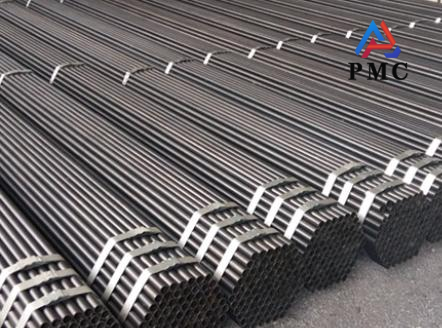
Theoretical Weight of Seamless Steel Pipe
Seamless steel pipe is a common steel product, widely used in oil, natural gas, chemical industry, aerospace and other fields. For the theoretical weight of seamless steel pipe, we need to discuss and analyze it from many aspects.
Calculation method of theoretical weight
The theoretical weight of seamless steel pipe can be calculated by the following formula:
Theoretical weight (kg/m) = (outer diameter (mm) - wall thickness (mm)) × wall thickness (mm) × 0.02466
In this formula, we need to know the outer diameter and wall thickness of the seamless steel pipe. The outer diameter refers to the outer diameter of the steel pipe, and the wall thickness refers to the thickness of the wall of the steel pipe. Through this formula, we can calculate the theoretical weight of the steel pipe per meter.
The following is a reference table of weight per meter of seamless steel pipes of common specifications (outer diameter × wall thickness, unit: mm):
|
Outside diameter × wall thickness |
Weight per meter (kg/m) |
Outside diameter × wall thickness |
Weight per meter (kg/m) |
Outside diameter × wall thickness |
Weight per meter (kg/m) |
|
10×1 |
0.247 |
32×3 |
2.145 |
89×4 |
8.383 |
|
14×2 |
0.592 |
45×3 |
3.107 |
108×4 |
10.259 |
|
18×2 |
0.816 |
57×3 |
3.995 |
133×5 |
15.780 |
|
25×2 |
1.163 |
76×4 |
7.140 |
159×6 |
22.638 |
|
27×3 |
1.832 |
80×4 |
7.600 |
219×8 |
41.626 |
Key Notes:
1. Material influence: If the material is stainless steel (density about 7.93g/cm³), the formula needs to be adjusted to:
Weight per meter (kg/m) = 0.02491 × wall thickness × (outer diameter - wall thickness).
2. Actual weight error: Seamless steel pipes may have wall thickness tolerance (about ±10%), and the actual weight shall be subject to the manufacturer's actual measurement.
3. Application scenarios:
Small specifications (such as 10×1, 14×2) are often used in instruments and medical equipment;
Medium and large specifications (such as 108×4, 219×8) are mostly used in petrochemicals, building structures, high-pressure pipelines, etc.

The influence of seamless steel pipe material on theoretical weight
The material of seamless steel pipe is one of the important factors affecting its weight.
Steel pipes made of different materials have different densities and strengths, so their weights will also vary. Generally speaking, high-strength steel pipes have a higher density, so steel pipes of the same size will be relatively heavier.
Theoretical weight difference of seamless steel pipes of different specifications
The specifications of seamless steel pipes will also affect their theoretical weight. The specifications include the outer diameter and wall thickness of the steel pipe, and the theoretical weight of steel pipes of different specifications will also be different. Generally speaking, steel pipes with larger outer diameters and thicker walls will weigh more.
Difference between theoretical weight and actual weight
It should be noted that the theoretical weight is only an estimate calculated based on the specifications and materials of the steel pipe, and is not completely equivalent to the actual weight of the steel pipe. The actual weight is also affected by factors such as manufacturing process, surface treatment, material purity, etc. Therefore, in practical applications, we need to take into account the impact of these factors on the weight of the steel pipe.
The influence of the weight of seamless steel pipe on the application
Steel pipes are widely used in various industries, and the weight of steel pipes plays an important role in the selection and design of their applications. For example, in oil transportation, if oil and gas are to be transported over long distances, lighter steel pipes will have more advantages; while in the construction field, for occasions with higher load-bearing requirements, heavier steel pipes may be more appropriate.
As we think about this, we can also consider some other viewpoints to gain more perspective.
1. Material selection
In addition to weight, the material of seamless steel pipes will also affect their corrosion resistance, strength and other properties. Therefore, when choosing seamless steel pipes, in addition to considering weight, other performance indicators also need to be considered comprehensively.
2. Improvement of manufacturing process
The manufacturing process of steel pipes will also affect their weight. By improving the process, the weight of steel pipes can be reduced and their efficiency and economy can be improved.
3. Environmental protection and sustainable development
With the increasing awareness of environmental protection and sustainable development, the steel industry is also working hard to reduce resource consumption and environmental pollution. When choosing steel pipes, you can also consider using lightweight materials to reduce the load on the environment.
Conclusion
In summary, the theoretical weight of seamless steel pipes is calculated by outer diameter and wall thickness, and is also affected by factors such as material and specification. In practical applications, it is also necessary to consider the impact of factors such as manufacturing process and material purity on the weight of steel pipes. When selecting steel pipes, we can also comprehensively consider other factors, such as material selection, manufacturing process improvement, and environmental protection, to meet the needs and requirements of different industries for steel pipe weight.
Read more: Weight Calculation Method of Carbon Steel Seamless Pipe


